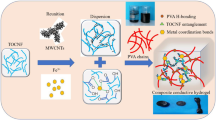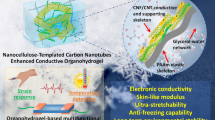Abstract
Conductive and self-healing hydrogels are among the emerging materials that mimic the human skin and are important due to their probable prospects in soft robots and wearable electronics. However, the mechanical properties of the hydrogel matrix limit their applications. In this study, we developed a physicochemically dual cross-linked chemically modified-cellulose nanofibers-carbon nanotubes/polyacrylic acid (TOCNF-CNTs/PAA) hydrogel. The TOCNFs acted both as a nanofiller and dispersant to increase the mechanical strength of the PAA matrix and break the agglomerates of the CNTs. The final self-healing and conductive TOCNF-CNTs/PAA-0.7 (mass ratio of CNTs to AA) hydrogel with a uniform texture exhibited highly intrinsic stretchability (breaking elongation to ca. 850%), enhanced tensile properties (ca. 59 kPa), ideal conductivity (ca. 2.88 S m− 1) and pressure sensitivity. Besides, the composite hydrogels achieved up to approximately 98.36% and 99.99% self-healing efficiency for mechanical and electrical properties, respectively, without any external stimuli. Therefore, the as-designed multi-functional self-healing hydrogels, combined with stretching, sensitivity, and repeatability, possess the ability to monitor human activity and develop multifunctional, advanced, and commercial products such as wearable strain sensors, health monitors, and smart robots.
Graphic abstract









Similar content being viewed by others
Data availability
The data that support the findings of this study are available from the corresponding author upon reasonable request.
References
Alias SA, Mhd Sarbon N (2019) Rheological, physical, and mechanical properties of chicken skin gelatin films incorporated with potato starch. NPJ Sci Food 3:26
Anjum S, Gurave P, Badiger MV, Torris A, Tiwari N, Gupta B (2017) Design and development of trivalent aluminum ions induced self-healing polyacrylic acid novel hydrogels. Polymer 126:196–205
Cai Y et al (2020) Mixed-dimensional MXene-hydrogel heterostructures for electronic skin sensors with ultrabroad working range. Sci Adv 6:eabb5367
Chen Y et al (2019) A skin-inspired stretchable, self-healing and electro-conductive hydrogel with a synergistic triple network for wearable strain sensors applied in human-motion detection. Nanomaterials 9:1737
Dai S, Wang S, Yan H, Xu J, Hu H, Ding J, Yuan N (2019) Stretchable and self-healable hydrogel-based capacitance pressure and strain sensor for electronic skin systems. Mater Res Express 6:0850b0859
Dong B, Wu S, Zhang L, Wu Y (2016) High performance natural rubber composites with well-organized interconnected graphene networks for strain-sensing application. Ind Eng Chem Res 55:4919–4929
Dong K et al (2018) A stretchable yarn embedded triboelectric nanogenerator as electronic skin for biomechanical energy harvesting and multifunctional pressure sensing. Adv Mater 30:1804944
Eom J et al (2017) Highly sensitive textile strain sensors and wireless user-interface devices using all-polymeric conducting fibers. ACS Appl Mater Interfaces 9:10190–10197
Fujisawa S, Ikeuchi T, Takeuchi M, Saito T, Isogai A (2012) Superior reinforcement effect of TEMPO-oxidized cellulose nanofibrils in polystyrene matrix: optical, thermal, and mechanical studies. Biomacromol 13:2188–2194
Gao B et al (2016a) Effect of a multiscale reinforcement by carbon fiber surface treatment with graphene oxide/carbon nanotubes on the mechanical properties of reinforced carbon/carbon composites. Compos A Appl S 90:433–440
Gao F, Zhang Y, Li Y, Xu B, Cao Z, Liu W (2016b) Sea cucumber-inspired autolytic hydrogels exhibiting tunable high mechanical performances, repairability, and reusability. ACS Appl Mater Interfaces 8:8956–8966
Gu G, Xu H, Peng S, Li L, Chen S, Lu T, Guo X (2019) Integrated soft ionotronic skin with stretchable and transparent hydrogel-elastomer ionic sensors for hand-motion monitoring. Soft Robot 6:368–376
Guo Y, Zhou X, Tang Q, Bao H, Wang G, Saha P (2016) A self-healable and easily recyclable supramolecular hydrogel electrolyte for flexible supercapacitors. J Mater Chem A 4:8769–8776
Guo Q, Luo Y, Liu J, Zhang X, Lu C (2018) A well-organized graphene nanostructure for versatile strain-sensing application constructed by a covalently bonded graphene/rubber interface. J Mater Chem C 6:2139–2147
Han J, Lu K, Yue Y, Mei C, Huang C, Wu Q, Xu X (2019a) Nanocellulose-templated assembly of polyaniline in natural rubber-based hybrid elastomers toward flexible electronic conductors. Ind Crop Prod 128:94–107
Han J et al (2019b) A self-healable and highly flexible supercapacitor integrated by dynamically cross-linked electro-conductive hydrogels based on nanocellulose-templated carbon nanotubes embedded in a viscoelastic polymer network. Carbon 149:1–18
Hu S et al (2019) Elastomeric conductive hybrid hydrogels with continuous conductive networks. J Mater Chem B 7:2389–2397
Huang Y et al (2015) A self-healable and highly stretchable supercapacitor based on a dual crosslinked polyelectrolyte. Nat Commun 6:10310
Isogai A, Saito T, Fukuzumi H (2011) TEMPO-oxidized cellulose nanofibers. Nanoscale 3:71–85
Jing X, Mi H-Y, Peng X-F, Turng L-S (2018) Biocompatible, self-healing, highly stretchable polyacrylic acid/reduced graphene oxide nanocomposite hydrogel sensors via mussel-inspired chemistry. Carbon 136:63–72
Koga H, Saito T, Kitaoka T, Nogi M, Suganuma K, Isogai A (2013) Transparent, conductive, and printable composites consisting of TEMPO-oxidized nanocellulose and carbon nanotube. Biomacromol 14:1160–1165
Krause B, Mende M, Pötschke P, Petzold G (2010) Dispersability and particle size distribution of CNTs in an aqueous surfactant dispersion as a function of ultrasonic treatment time. Carbon 48:2746–2754
Kumar P, Maiti UN, Lee KE, Kim SO (2014) Rheological properties of graphene oxide liquid crystal. Carbon 80:453–461
Li T, Li Y, Zhang T (2019) Materials, structures, and functions for flexible and stretchable biomimetic sensors. Acc Chem Res 52:288–296
Liu Y, He K, Chen G, Leow WR, Chen X (2017) Nature-inspired structural materials for flexible electronic devices. Chem Rev 117:12893–12941
Liu S, Li K, Hussain I, Oderinde O, Yao F, Zhang J, Fu G (2018a) A conductive self-healing double network hydrogel with toughness and force sensitivity. Chem Eur J 24:6632–6638
Liu S, Oderinde O, Hussain I, Yao F, Fu G (2018b) Dual ionic cross-linked double network hydrogel with self-healing, conductive, and force sensitive properties. Polymer 144:111–120
Lu S et al (2018) Diallyl dimethyl ammonium chloride-grafted cellulose filter membrane via ATRP for selective removal of anionic dye. Cellulose 25:7261–7275
Ma P-C, Siddiqui NA, Marom G, Kim J-K (2010) Dispersion and functionalization of carbon nanotubes for polymer-based nanocomposites: a review. Compos A Appl S 41:1345–1367
Massoumi B, Jaymand M, Samadi R, Entezami AA (2014) In situ chemical oxidative graft polymerization of thiophene derivatives from multi-walled carbon nanotubes. J Polym Res 21:422
Olivier C, Moreau C, Bertoncini P, Bizot H, Chauvet O, Cathala B (2012) Cellulose nanocrystal-assisted dispersion of luminescent single-walled carbon nanotubes for layer-by-layer assembled hybrid thin films. Langmuir 28:12463–12471
Saito T, Nishiyama Y, Putaux JL, Vignon M, Isogai A (2006) Homogeneous suspensions of individualized microfibrils from TEMPO-catalyzed oxidation of native cellulose. Biomacromol 7:1687–1691
Schwartz G, Tee BC, Mei J, Appleton AL, Kim DH, Wang H, Bao Z (2013) Flexible polymer transistors with high pressure sensitivity for application in electronic skin and health monitoring. Nat Commun 4:1859
Shao C, Chang H, Wang M, Xu F, Yang J (2017) High-strength, tough, and self-healing nanocomposite physical hydrogels based on the synergistic effects of dynamic hydrogen bond and dual coordination bonds. ACS Appl Mater Interfaces 9:28305–28318
Sun X et al (2020) Carbon nanotubes reinforced hydrogel as flexible strain sensor with high stretchability and mechanically toughness. Chem Eng J 382:122832
Šupová M, Martynková GS, Barabaszová K (2011) Effect of nanofillers dispersion in polymer matrices: a review. Sci Adv Mater 3:1–25
Tan X, Wang Y, Du W, Mu T (2020) Top-down extraction of silk protein nanofibers by natural deep eutectic solvents and application in dispersion of multiwalled carbon nanotubes for wearable sensing. ChemSusChem 13:321–327
Tang C, Zhou T, Yang J, Zhang Q, Chen F, Fu Q, Yang L (2011) Wet-grinding assisted ultrasonic dispersion of pristine multi-walled carbon nanotubes (MWCNTs) in chitosan solution. Colloid Surface B 86:189–197
Varga M et al (2017) Diamond/carbon nanotube composites: Raman, FTIR and XPS spectroscopic studies. Carbon 111:54–61
Wan C, Li J (2016) Graphene oxide/cellulose aerogels nanocomposite: preparation, pyrolysis, and application for electromagnetic interference shielding. Carbohydr polym 150:172–179
Wan C, Jiao Y, Wei S, Zhang L, Wu Y, Li J (2019) Functional nanocomposites from sustainable regenerated cellulose aerogels: a review. Chem Eng J 359:459–475
Wang X, Dong L, Zhang H, Yu R, Pan C, Wang ZL (2015) Recent progress in electronic skin. Adv Sci 2:1500169
Wang T et al (2018a) A self-healable, highly stretchable, and solution processable conductive polymer composite for ultrasensitive strain and pressure sensing. Adv Funct Mater 28:1705551
Wang Y et al (2018b) A novel design strategy for triple-network structure hydrogels with high-strength, tough and self-healing properties. Polymer 135:16–24
Wei Z et al (2013) Autonomous self-healing of poly(acrylic acid) hydrogels induced by the migration of ferric ions. Polym Chem 4:4601
Xia S, Song S, Jia F, Gao G (2019) A flexible, adhesive and self-healable hydrogel-based wearable strain sensor for human motion and physiological signal monitoring. J Mater Chem B 7:4638–4648
Xu J, Wang G, Wu Y, Ren X, Gao G (2019) Ultrastretchable wearable strain and pressure sensors based on adhesive, tough, and self-healing hydrogels for human motion monitoring. ACS Appl Mater Interfaces 11:25613–25623
Yang W, Shao B, Liu T, Zhang Y, Huang R, Chen F, Fu Q (2018) Robust and mechanically and electrically self-healing hydrogel for efficient electromagnetic interference shielding. ACS Appl Mater Interfaces 10:8245–8257
Yang J, Luo S, Zhou X, Li J, Fu J, Yang W, Wei D (2019a) Flexible, tunable, and ultrasensitive capacitive pressure sensor with microconformal graphene electrodes. ACS Appl Mater Interfaces 11:14997–15006
Yang JC, Mun J, Kwon SY, Park S, Bao Z, Park S (2019b) Electronic skin: recent progress and future prospects for skin-attachable devices for health monitoring, robotics, and prosthetics. Adv Mater 31:1904765
Yu H, Chen P, Chen W, Liu Y (2014) Effect of cellulose nanofibers on induced polymerization of aniline and formation of nanostructured conducting composite. Cellulose 21:1757–1767
Yue Y, Luo H, Han J, Chen Y, Jiang J (2020) Assessing the effects of cellulose-inorganic nanofillers on thermo/pH-dual responsive hydrogels. Appl Surf Sci 528:146961
Zhang T, Cheng Q, Ye D, Chang C (2017) Tunicate cellulose nanocrystals reinforced nanocomposite hydrogels comprised by hybrid cross-linked networks. Carbohydr Polym 169:139–148
Zheng C et al (2020) A stretchable, self-healing conductive hydrogels based on nanocellulose supported graphene towards wearable monitoring of human motion. Carbohydr Polym 250:116905
Zhong M, Liu YT, Liu XY, Shi FK, Zhang LQ, Zhu MF, Xie XM (2016) Dually cross-linked single network poly(acrylic acid) hydrogels with superior mechanical properties and water absorbency. Soft Matter 12:5420–5428
Acknowledgments
This work was funded by National Natural Science Foundation of China (31770609, 31901274), Natural Science Foundation of Jiangsu Province for Outstanding Young Scholars (BK20180090), Qing Lan Project of Jiangsu Province (2019), 333 Project Foundation of Jiangsu Province (BRA2018337), 13th China Special Postdoctoral Science Foundation (2020T130303), China Postdoctoral Science Foundation (2019M661854), Postdoctoral Science Foundation of Jiangsu Province (2019K142), Priority Academic Program Development (PAPD), and Analysis and Test Center of Nanjing Forestry University.
Author information
Authors and Affiliations
Corresponding authors
Additional information
Publisher’s note
Springer Nature remains neutral with regard to jurisdictional claims in published maps and institutional affiliations.
Supplementary Information
Rights and permissions
About this article
Cite this article
Jiao, Y., Lu, K., Lu, Y. et al. Highly viscoelastic, stretchable, conductive, and self-healing strain sensors based on cellulose nanofiber-reinforced polyacrylic acid hydrogel. Cellulose 28, 4295–4311 (2021). https://doi.org/10.1007/s10570-021-03782-1
Received:
Accepted:
Published:
Issue Date:
DOI: https://doi.org/10.1007/s10570-021-03782-1




